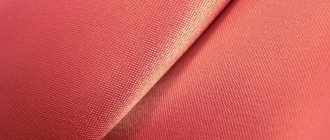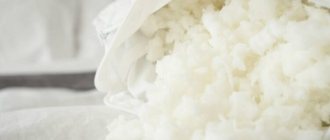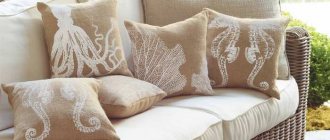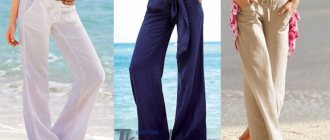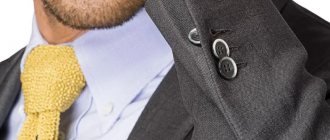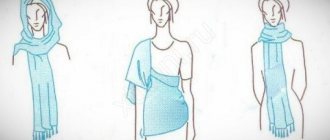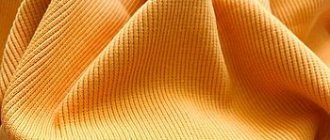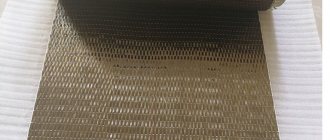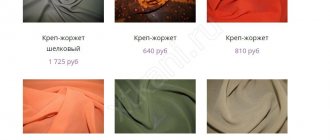There is no such fabric that would excite the minds of fashionistas the way crimplene did. At least Soviet fashionistas. Every self-respecting beauty should have at least one, or better yet two, outfits made of crimplene in her wardrobe.
But, as Coco Chanel said: “Fashion is what goes out of fashion.” So the crimplen quickly lost their ground. After all, his main trump card - durability - has become his disadvantage. No woman wants to wear the same dress for years.
Chanel, Coco
French fashion designer, founder of the Chanel fashion house.
What type of fabric is this
Crimplene is an easily washable, wrinkle-resistant synthetic fiber fabric. It is made from polyester synthetic fibers using the false twist method. Fibers twisted in this way come out of the spinning machines with volume, while remaining strong and thin. Then, in other machines, the threads are subjected to thermal effects, which makes the fibers soft. Later the threads are woven into cloth.
Crimplene colors
Crimplene is produced in all post-Soviet countries; in Western Europe, its main supplier to the world market is Germany. Italian crimplen is distinguished by its refined design and bright colors.
Catalog of synthetic fiber fabrics
Production of material
As already mentioned, various polymers are used as raw materials for the production of crimple fabrics.
To form yarn, the method of “false twisting” of synthetic fibers is used. This allows the threads to be formed in such a way that when they exit the spinning machines they remain thin, dense and strong, but at the same time gain volume. After this, the semi-finished product is subjected to special heat treatment. This gives the threads softness and makes them visually similar to natural wool. Then they are made into canvas.
In modern crimplen during fabric production they also add:
- viscose;
- polyamide;
- elastane and other synthetic components.
The finished canvas, depending on the subsequent purpose, can be of different thickness and texture. The front side of the fabric can be either smooth or textured. At the same time, the buyer is offered several options for this unique decor, from a simple hem, to curls of various shapes and sizes, to a moire pattern. This design of the crimplen surface gives the finished fabric a unique originality and makes it easily recognizable at first sight.
History of the origin of crimplen
This synthetic matter appeared in the UK in the laboratory of a well-known chemical company in 1946. The name was given to it by the Krimpal Valley, where this laboratory was located. To be fair, it must be said that three years later in the USSR an analogue of this fabric was created, called lavsan.
Lavsan
Oil fabric lavsan: what is known about it? What are its characteristics?
more details
But it was used only in the defense industry, and Soviet women were forced to “chase” imported cream.
History of Crimplene
Crimplene is made from 100% artificial material - polyester fibers, which are then made into yarn. The birthplace of the fabric is considered to be Great Britain, where a patent for this invention was received in 1946.
However, a similar raw material, called lavsan, was also obtained in the USSR in 1949, where at first it was used exclusively in the defense industry. But the unique characteristics of the fibers have made it possible to find other applications for lavsan-based threads. They began to be used to produce fabrics for civilian purposes.
Crimplene was first used as a material for sewing clothing in the 50s of the 20th century. Then a small collection of finished products was presented to the European public. However, it did not arouse much interest, remaining virtually unnoticed. Then the attempt to introduce new material failed.
People really started talking about the fabric only after a short dress made of crimplen was presented by a famous couturier at one of the next fashion shows. This time everything was different. The unusual and spectacular image appealed to the fashionable community, and a little later everyone else was able to appreciate the clothes made from crimplene. Taking into account the world's general fascination with synthetic materials, this turned out to be predictable.
The popularity of fashionable artificial fabric quickly began to gain momentum, but its peak occurred in the 70s of the 20th century. At that time, things and textiles made from crimplene were in great demand, especially in socialist countries and the USSR. Almost everything was sewn from this fabric: from underwear and swimsuits to light coats. Buyers refused to purchase products made from natural ingredients, preferring the famous and fashionable crimplene.
For two decades, the demand for this fabric was unusually high. But then everything changed. With the development of the chemical and textile industries, other synthetic materials began to appear with characteristics that were more attractive to buyers. In addition, fabrics and knitwear made from natural fibers, as well as mixed fabrics, which now represented serious competition to artificial materials, began to return to fashion. In such conditions, the production of the once popular crimplene began to decline, and today only a few manufacturers are engaged in its production.
Fabric composition and its properties
Crimplen consists of synthetic threads - lavsan or polyester. Modern manufacturers include other threads in the composition: viscose (increases breathability), elastane (increases elasticity) and polyamide, which makes the surface of the fabric smoother.
Crimplene properties:
Does not wrinkle or shrink during washing
Strength and high wear resistance
Keeps its shape well
Does not fade under sunlight
Composition and production of material
Initially, the fabric contained only polyester fibers. Currently, polyester is mixed with other synthetic and artificial materials: viscose, elastane, polyamide, etc. The yarn is made using the false twist method, which makes it possible to obtain strong, thin, but voluminous threads. Finished canvases have different thicknesses and textures. The front side is often embossed - in the form of a rib, moiré pattern, or ornate pattern. The shades of the material are varied - from pastel to bright neon. Printed designs are often used for decoration.
Advantages and disadvantages
Positive qualities of crimp:
- inelastic, can be used for years, will not stretch or deform;
- antibacterial, bacteria do not linger on its surface;
- clothes made from crimplene do not wrinkle even after long-term storage in a folded form;
- easy to care for, does not require expensive delicate detergents.
Like all synthetic fabrics, it has many disadvantages:
- poor breathability: clothes made of this material are cold in winter, hot in summer;
- high electrostaticity, especially in the cold season;
- does not absorb moisture well, but if it gets wet, it takes a long time to dry;
- may cause allergies in people with sensitive skin;
- the fabric does not drape well, so the choice of styles is small;
- the material is very afraid of the slightest spark: even the ash from a cigarette can burn a hole and irrevocably damage the thing.
Advantages and disadvantages
Despite the advantages of the material, it is currently unpopular because Modern fabrics with improved characteristics have become widespread.
Advantages:
- retains heat at average temperatures;
- does not allow moisture to pass through with minor ingress;
- partially breathable;
- elastic, does not restrict movement;
- wear-resistant;
- looks impressive;
- does not wrinkle;
- has low cost.
Flaws:
- Crimplene clothes are hot in summer and cold in winter;
- when completely wet, high water permeability;
- takes a long time to dry;
- breathability is lower than that of natural and artificial fibers.
If you still have crimple items in your wardrobe, then most likely the quality and condition allows you to wear them to a retro party.
What standards are used in production? What do they take into account?
All standards for the production of synthetic fabrics, including crimplene, are enshrined in GOST 29298-2005 Cotton and mixed household fabrics. General technical conditions":
- hygroscopicity - compliance with GOST3816-81;
- water resistance - GOST 12088-77;
- thread stretching - GOST 3813-72;
- color fastness to light - GOST 9733.1-91;
- color fastness to washing - GOST 9733.4-83;
- electrostaticity - GOST 19616-74.
Application of crimplen
Crimplene is used to make outerwear. Women's and men's lightweight demi-season coats are made from the densest textured fabrics.
These are things made in different styles, but characterized by a minimum of decor, since the material itself is quite elegant and does not imply unnecessary additions. Jackets, jackets, skirts and trousers can also be made from this material. But dresses made from crimplene remain the most popular.
Retro style is coming back, and those who want to look trendy today should take a closer look at the fashion of the 60s, when this particular material was at the height of its popularity.
This time is characterized by short or medium length, as well as several basic styles:
- simple semi-fitted silhouette;
- small trapezoid;
- T-shirt dress;
- fitted dress made of crimplene with a deep neckline and a year skirt.
At the same time, the original is easy to find at home among old things. Such outfits belong to the vintage category. Modern designers working with crimple do not strictly adhere to the traditions of the past. They simply take classic silhouettes as the basis for their designs, but add new and interesting details to them.
Unlike the real style of the 60s, current outfits are distinguished by:
- asymmetry of parts;
- high waist;
- lace trim;
- use of a corset.
Only the well-proven crimplen remains unchanged. Popular materials include bright checkered patterns, classic polka dots, or floral motifs. For plain fabrics, you should take a closer look at old dresses in blue, red and pink.
For what purposes can it be used?
Crimplene became popular in the 60s and 70s of the 20th century.
Then they made clothes from it:
Swimwear
Baby clothes
Suits
Coat
Crimplene dress
Of course, the fashion for crimple has long since faded away and now it is used mainly to make clothes for retro shows. Seventies styles are in fashion - trapezoidal dresses in bright colors, and crimplein is an ideal option for such models.
What kind of fabric
Crimplene is a soft, elastic, voluminous fabric. Its front side is slightly rough to the touch, in most cases with a textured pattern.
The material began to be produced in the 50s of the last century. In the 60s, crimplein became fashionable in the West. Women's and men's clothing and home textiles were made from it.
The history of crimp in the USSR began in the late 60s, and the peak of popularity came in the 70s. Fashionistas went crazy and were ready to give any money for a cut. No one was stopped by the discomfort caused by poor breathability and the ability to accumulate static electricity.
Crimplene was used to make fashionable dresses, including wedding ones. The latter were considered a special chic. Men's shirts and suits, skirts, jackets, and raincoats were made from it.
Curtains made of brightly colored fabric with a print (polka dots or diamonds) have become an indispensable attribute in many homes. The material was used for sewing bedspreads and other home textiles.
Closer to the 80s of the 20th century, the fashion for fabric passed. The material began to be produced in significantly smaller volumes. Now interest in crimplen is growing; time will tell whether it will get a second life.
The material is produced in Turkey, India, China, Germany, and Ukraine. Modern fabric is not inferior in strength and wear resistance to Soviet fabrics. But modern manufacturers have a wider choice of colors and prints.
At online sales you can buy vintage cuts from the 70s, produced in the USSR or Eastern Europe.
